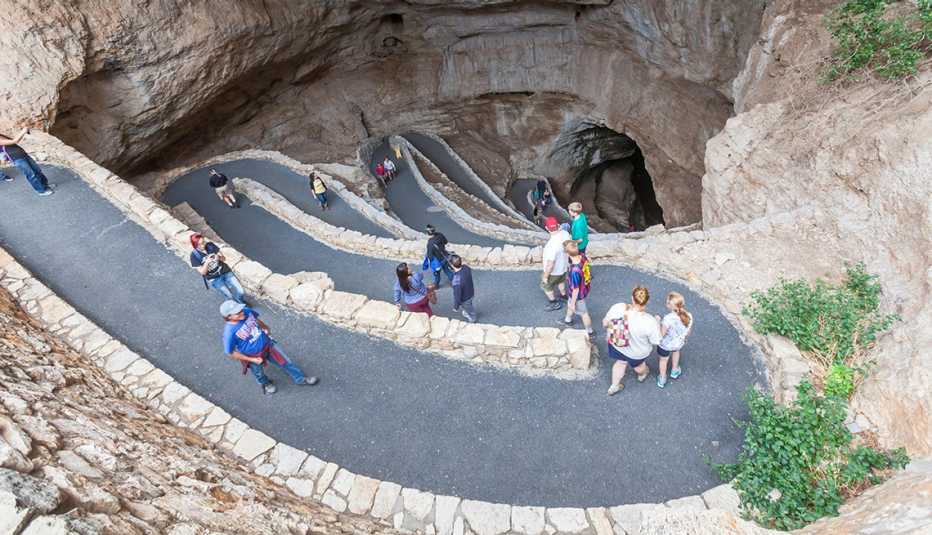AARP Hearing Center
In southern New Mexico, where the Chihuahuan Desert’s vast plains rise up to meet the foothills of the rugged Guadalupe Mountains, lies one of the most unique experiences in the National Park Service: Carlsbad Caverns (CCNP). These are some of the deepest, largest and most unique caverns ever discovered, and they’ve been protected by the NPS since 1923. Until you descend into the depths, it’s hard to comprehend the massiveness of these caves. The actor Will Rogers described the cavern system as a “Grand Canyon with a roof over it.”
The largest cave measured in the park, Lechuguilla Cave, stretches more than 140 miles, with a depth of more than 1,600 feet. It’s off-limits to anyone but researchers, but other caves open to visitors are wildly impressive. The Big Room, North America’s largest single cave chamber by volume that you can explore, is a limestone chamber that’s 255 feet high. Stalactites, many as long as 60 feet, drip from its ceiling, and spectacular stalagmites, some six stories tall, rise from the floor. Delicate “soda straw” formations, cave pools, shimmering “popcorn” structures and brilliant speleothems add to the spectacle. “Some of the formations can be 150 to 200 feet tall, and they even seem taller than that when you’re standing there looking at them,” says Michael Larson, the park’s public information officer and chief of interpretation and education.
Together, they give this cavern system with 120 known caves that’s millions of years old an ornate, baroque feel, like walking through a Gothic cathedral. At times it can feel like walking on another planet — and in some ways you are. The elevator that takes visitorsdown stops at 754 feet below the Earth’s surface, and walking around at this depth, where subtle lights guide your way, is unlike anything you’ve ever experienced topside.


Facts box
Location: Carlsbad, New Mexico
Total acres: 46,766
Highest elevation: 6,368 feet
Miles of trails: More than 50 miles of backcountry trails
Main attraction: The underground cavern system, with 120 known caves
Cost: $15 per person; reservations ($1) required
Best way to see it: On a ranger-guided tour
When to go: September or October, when the bats still take flight each night, the days arecooler, and the peak tourism season is over
Above ground is spectacular, too. The 46,766-acre park is situated at the northern end of the Chihuahuan Desert, with piñon and juniper trees in its higher elevations and grasslands in its lower corners. Thanks to this merging of ecological zones, it teems with life, including 750 plant species and 67 mammals, ranging from black bear and mule deer to the Chihuahuan Desert pocket mouse. The park’s most famous mammals are its 17 batspecies, three of which roost inside the cavern system. The flights have become such an attraction that the park built amphitheater seating and created a Bat Flight Program so visitors can take in the sight more comfortably, with rangers on hand to answer questions and offer insight into the phenomenon.
Unlike Yellowstone or Yosemite National Parks, you can experience most of Carlsbad Caverns in one day, although it’s diverse enough to spend two or three days exploring.


Plan your trip
Unlike most national parks, Carlsbad Caverns requires advanced reservations for entry; make sure you book before your arrival because they can’t be made on-site. Reservations cost $1, and they’re limited to a 60-minute window based on the time you choose. For example, if you select a 10:30 a.m. slot, you only have until 11:30 a.m. to enter. Once you arrive at the visitor center, you must pay an entrance fee of $15 per person. Once inside, you can stay until that day’s closing.
Given the park’s remoteness, getting there will probably require going out of your way — or making it a destination in itself. But the effort is more than worth the exhilaration inspired by venturing into its depths. Most visitors come from El Paso, 149 miles to the west, but another option is Albuquerque, 302 miles northwest. Although much farther, the latter offers a road trip option in which you see some of the most interesting attractions in southern New Mexico, including the town of Roswell, home of the 1947 “flying disc” incident.
The visitor center, 7 miles into the park on Carlsbad Caverns Highway, has restrooms, a cafeteria, bookstore, information desk and hands-on educational exhibits. From here, you can take an elevator down into the cavern system. Or walk down into it from theNatural Entrance Trail, which begins a short walk away.
































































